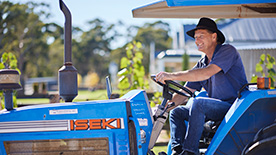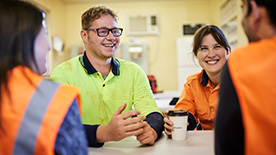877752
Simple steps to safety self audit tool results
 line
line
 line
line
 line
line
 line
line
 line
line
 line
line
 line
line
You’re on the right track, but there is more you can do to help with defining safety roles and responsibilities.
Your responses indicate that you need to be more consistent with your approach to health and safety. Ask yourself: Are safety responsibilities effectively communicated? Have you allowed adequate resources to meet safety responsibilities? Are you involved in safety issues?
What you can do to improve:
Ensure safety responsibilities are clearly defined and understood
Your workers will contribute to safety if they understand their responsibilities; and have the skills to meet those responsibilities.
Are your workers given induction training that includes safety information and outlines their safety responsibilities? Do they have clear instructions on how to deal with safety issues? Do supervisors understand their role in ensuring safety in the workplace?
Review resources to support safety initiatives
Demonstrate your commitment by providing enough time and money to deal with safety problems and to fix problems when they arise. Where problems cannot be fixed immediately, provide an alternate solution.
Demonstrate your commitment
Get actively involved with safety issues when they arise. Attend workplace meetings regularly. Speak with your workers and act upon their feedback. Ensure solutions to safety problems are implemented promptly by those responsible.
Useful links
You’re on the right track, but there is more you can do to help with defining safety roles and responsibilities.
Your responses indicate that you need to be more consistent with your approach to health and safety. Ask yourself: Are safety responsibilities effectively communicated? Have you allowed adequate resources to meet safety responsibilities? Are you involved in safety issues?
What you can do to improve:
Ensure safety responsibilities are clearly defined and understood
Your workers will contribute to safety if they understand their responsibilities; and have the skills to meet those responsibilities.
Are your workers given induction training that includes safety information and outlines their safety responsibilities? Do they have clear instructions on how to deal with safety issues? Do supervisors understand their role in ensuring safety in the workplace?
Review resources to support safety initiatives
Demonstrate your commitment by providing enough time and money to deal with safety problems and to fix problems when they arise. Where problems cannot be fixed immediately, provide an alternate solution.
Demonstrate your commitment
Get actively involved with safety issues when they arise. Attend workplace meetings regularly. Speak with your workers and act upon their feedback. Ensure solutions to safety problems are implemented promptly by those responsible.
Useful links
Your consultation arrangements are effective and workers are involved in decisions regarding safety.
Your responses indicate that you have implemented effective consultation processes and that you actively encourage your worker’s participation and value their views.
What you can do to maintain this:
Review your consultation arrangements periodically with your workers and ensure the arrangements continue to work effectively
Ensure that all of your workers including young workers, workers from a non-English speaking background or workers with literacy difficulties are adequately represented in the consultation process and that their views are sought and valued.
Useful links
Your consultation arrangements are effective and workers are involved in decisions regarding safety.
Your responses indicate that you have implemented effective consultation processes and that you actively encourage your worker’s participation and value their views.
What you can do to maintain this:
Review your consultation arrangements periodically with your workers and ensure the arrangements continue to work effectively
Ensure that all of your workers including young workers, workers from a non-English speaking background or workers with literacy difficulties are adequately represented in the consultation process and that their views are sought and valued.
Useful links
You identify and control hazards and risks and your workers are using safe work procedures to help them do their job safely.
Your responses indicate that you are effectively managing safety risks in your workplace through your safe work procedures.
What you can do to maintain this:
Continuously review your hazards and risks as well as your safe work procedures
Changes in the workplace including new equipment, new ways of doing things and even new workers can render hazard and risk controls obsolete. Make sure you keep reviewing your hazards and risks to make sure your controls remain effective. In the same way your safe work procedures should be reviewed regularly to ensure their effectiveness.
Useful links
You identify and control hazards and risks and your workers are using safe work procedures to help them do their job safely.
Your responses indicate that you are effectively managing safety risks in your workplace through your safe work procedures.
What you can do to maintain this:
Continuously review your hazards and risks as well as your safe work procedures
Changes in the workplace including new equipment, new ways of doing things and even new workers can render hazard and risk controls obsolete. Make sure you keep reviewing your hazards and risks to make sure your controls remain effective. In the same way your safe work procedures should be reviewed regularly to ensure their effectiveness.
Useful links
Your business views health and wellbeing of employees as a priority and plans and programmes are in place which address both physical and mental health issues.
Your responses indicate that you have a wellbeing program in place which actively encourages healthy lifestyle options, standard reporting systems include the reporting of workplaces issues that could contribute to work-related stress and measures are in place for the prevention of bullying and harassment.
What you can do to maintain this:
Put in place measures to review the effectiveness of your wellbeing program to ensure it continues to meet the needs of the workforce and any changing circumstances
Ensure leadership continues to take a visible and active involvement in the health and wellbeing program and staff are consulted so that the wellbeing program continues to address the needs of the workforce.
Monitor incident reporting systems to ensure work-related stressors are being reported and appropriate controls are put in place.
Continue to look for opportunities where health and wellbeing can be integrated and embedded into organisational systems and processes such as induction programs, WHS systems, education programs and overall business plans.
Consider how your business can evaluate the health and wellbeing program such as through changes in knowledge and attitudes of workers, records of participation, staff surveys, staff engagement levels and in the longer term, staff retention rates, absenteeism rates and workers compensation claims/premiums.
Your business views health and wellbeing of employees as a priority and plans and programmes are in place which address both physical and mental health issues.
Your responses indicate that you have a wellbeing program in place which actively encourages healthy lifestyle options, standard reporting systems include the reporting of workplaces issues that could contribute to work-related stress and measures are in place for the prevention of bullying and harassment.
What you can do to maintain this:
Put in place measures to review the effectiveness of your wellbeing program to ensure it continues to meet the needs of the workforce and any changing circumstances
Ensure leadership continues to take a visible and active involvement in the health and wellbeing program and staff are consulted so that the wellbeing program continues to address the needs of the workforce.
Monitor incident reporting systems to ensure work-related stressors are being reported and appropriate controls are put in place.
Continue to look for opportunities where health and wellbeing can be integrated and embedded into organisational systems and processes such as induction programs, WHS systems, education programs and overall business plans.
Consider how your business can evaluate the health and wellbeing program such as through changes in knowledge and attitudes of workers, records of participation, staff surveys, staff engagement levels and in the longer term, staff retention rates, absenteeism rates and workers compensation claims/premiums.
Your workers are adequately trained and supervised to be safe at work.
Your responses indicate that you have good processes in place for education and supervision of your workers.
What you can do to maintain this:
Continuously review your process of training, induction and supervision
Changes in the workplace including new equipment, new ways of doing things and even new workers can render old processes obsolete. Make sure you keep reviewing your hazards and risks to make sure your education and supervision remains effective.
Useful links
Your workers are adequately trained and supervised to be safe at work.
Your responses indicate that you have good processes in place for education and supervision of your workers.
What you can do to maintain this:
Continuously review your process of training, induction and supervision
Changes in the workplace including new equipment, new ways of doing things and even new workers can render old processes obsolete. Make sure you keep reviewing your hazards and risks to make sure your education and supervision remains effective.
Useful links
You are providing and maintaining a safe workplace for your workers.
Your responses indicate that you are regularly checking workplace work health and safety and identifying any changes or issues that may require you to reconsider existing procedures or processes.
You have a regular documented preventative maintenance programme in place and you ensure your plant and equipment is in safe working order.
You have an effective incident and injury reporting process in place. Your workers are trained in the process and all are notified of any outcome.
Your workplace has appropriate emergency procedures in place and these are tested regularly.
What you can do to maintain this:
Continuously review your process of training, induction and supervision
Changes in the workplace including new equipment, new ways of doing things and even new workers can render old processes obsolete. Make sure you keep reviewing your hazards and risks to make sure your education and supervision remains effective.
Useful links
You are providing and maintaining a safe workplace for your workers.
Your responses indicate that you are regularly checking workplace work health and safety and identifying any changes or issues that may require you to reconsider existing procedures or processes.
You have a regular documented preventative maintenance programme in place and you ensure your plant and equipment is in safe working order.
You have an effective incident and injury reporting process in place. Your workers are trained in the process and all are notified of any outcome.
Your workplace has appropriate emergency procedures in place and these are tested regularly.
What you can do to maintain this:
Continuously review your process of training, induction and supervision
Changes in the workplace including new equipment, new ways of doing things and even new workers can render old processes obsolete. Make sure you keep reviewing your hazards and risks to make sure your education and supervision remains effective.
Useful links
Your workers are reporting all incidents, they are investigated and corrective actions put in place as needed.
Your responses indicate that you have an established incident reporting procedure and that you investigate incidents as they occur. You also put in place and monitor corrective actions.
What you can do to maintain this:
Monitor and analyse your incident reports to identify any trends and help you to improve your safety
Use your incident reports and investigations to monitor your workplace safety and identify any gaps in your system. These reports can be a valuable tool in prevention by allowing you to address any emerging issues before they become too big or cause major injury.
Useful links
Your workers are reporting all incidents, they are investigated and corrective actions put in place as needed.
Your responses indicate that you have an established incident reporting procedure and that you investigate incidents as they occur. You also put in place and monitor corrective actions.
What you can do to maintain this:
Monitor and analyse your incident reports to identify any trends and help you to improve your safety
Use your incident reports and investigations to monitor your workplace safety and identify any gaps in your system. These reports can be a valuable tool in prevention by allowing you to address any emerging issues before they become too big or cause major injury.
Useful links
Need more help?
SafeWork SA
SafeWork SA’s WHS advisors can visit your workplace to help you understand your work health and safety responsibilities as well as provide practical support to improve your systems, practices and general approach to safety.
Phone: 1300 365 255
help.safework@sa.gov.au
www.safework.sa.gov.au
Twitter: @SafeWorkSA
Facebook: @safeworksa
ReturnToWorkSA
Phone: 13 18 55
Injury prevention: injuryprevention@rtwsa.com
Mentally healthy workplaces: mentallyhealthy@rtwsa.com
Return to work coordinator support service: coordinators@rtwsa.com
Action plan
| Hazard/Risk | Actions | Responsible | Review Date | Due Date | Complete Date | Comments |
|---|






 Date printed: 01 Jul 2025
Date printed: 01 Jul 2025

